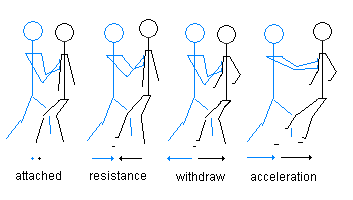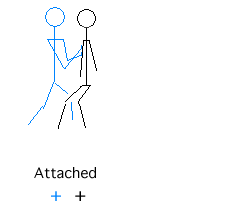| ||||||
Notes on the Tai Chi training method called Ti FangBy Stephen J. Goodson1999 Ti Fang (lit: lift/let-go) is the name of a training exercise in Tai Chi. It is used to teach the student how to uproot their opponent without using strength. It is best taught just after the student has learned the choreography of the Push Hands exercise. To practice Ti Fang you get into the basic push hands set-up with your feet shoulder-width apart, waist facing forward in bow/arrow (a.k.a.: 70/30) posture. Your partner is in a 100% rear weighted posture. As if standing on a railroad track your partner's feet would be on the same 'tracks' as yours. The difference between the Push Hands foot placement and Ti Fangs foot placement is that you are very close to your partner in the Ti Fang set-up. Your front foot is almost touching his rear foot, the same is true for your other foot (being too close is so that you have the advantage and can make less errors during the exercise). Your partner should be 100% rear weighted and upright (they should be able to hover their front foot one inch above the ground if you asked them to). They should be "holding their posture" with their arms just hanging down. They are just standing there, they should not try to neutralize or yield, or use their arms in anyway. This is an exercise for you to learn Ti Fang, not for your partner to learn neutralizing techniques. Usually your partner's body will be slightly sideways to you, "offering their shoulder" for you to push on. Their arms should naturally hang down touching their body. You can then place both hands on your partner's arm, one on the upper arm and the other wherever comfortable. This is the Ti Fang set-up. In the Ti Fang exercise, your initial contact with your partner is at 4oz of pressure. You should have a good feel for this amount of pressure from the preliminary learning of the Push Hands choreography. Suffice to say that it's just about 4oz. Once this contact is established you then start to gently push. When the pressure builds to just more than 4oz [say 5oz] they will reflexively raise slightly, you then withdraw to just under 4oz of pressure [say 3oz, but don't disconnect], and then you accelerate them [pushing through their center]. The withdraw "severs the root" of your opponent so that when you accelerate them away you meet little/no resistance. If you get it right both his feet will leave the ground as he hops away. As you push into your partner the pressure increase above 4oz should be your mark to withdraw -- but never disconnect. Withdraw and push, "Attract to emptiness, and discharge - without resistance and without letting go". The withdraw is very subtle, but without it you do not sever their root and you would have to use brute force to move them. This is not an exercise of "mechanics" so much as an exercise of tapping into their reflexes. In addition, there is a moment, a feeling, just after you withdraw and just before you accelerate them, where you must 'harmonize' with their body. Since their body is falling towards you, they deliver their "center" into your hands. Yet at the same time their muscles are reflexively pulling away from you, your acceleration meets no resistance. I refer to this moment, this feeling, as "catching" them. The push has been described as being "like pushing a child in a swing." Give it a try! In the beginning your partner should be 100% rear weighted, upright and holding his position, later they can be in any posture, any position. At first try it with just your arms doing the pushing, once you get the feel of it, then start to add your legs into the acceleration. With a little practice you should be getting distances of twenty or more feet with very little effort. The Tai Chi Classics say "use 4oz to deflect 1000lbs", this is the goal of this exercise. Ti Fang is to be incorporated into the practice of Push Hands and anytime too much pressure is felt you will simply withdraw and push -- Ti Fang!  
©1999 Stephen J. Goodson |